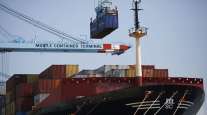Domestic Intermodal Up 9%, Fueled by East Coast Growth
This story appears in the Aug. 12 print edition of Transport Topics.
A 9% surge in domestic container shipping, fueled by growth in the eastern United States, led to 2.4% overall growth in intermodal shipping during the second quarter, according to a new report.
The Intermodal Association of North America said Aug. 5 that trucks and railroads moved 3.86 million containers and trailers during the three months ended June 30, up from 3.77 million during the same time in 2012 — the record year for intermodal.
“Domestic container volume was the foundation of intermodal growth in both the second quarter and year to date,” IANA President Joni Casey said.
The IANA report noted the stronger growth in the East, which was attributed to more traffic gained from trucking.
The six-month pace for intermodal is 3.4% ahead of the 2012 rate, with 7.54 million units moved, up from 7.29 million.
Schneider National, of Green Bay, Wis., said business in the eastern United States is strong.
“Eastern over-the-road conversion to intermodal is hot,” said Jim Filter, a Schneider vice president for intermodal. “Two-thirds of our growth is coming from new customers. That’s truly significant.”
Filter said pure truck transportation is increasingly difficult in the East because of highway congestion, federal regulations and the ongoing driver shortage. At the same time, railroads have invested billions of dollars in infrastructure for improved service levels while Schneider is adding tracking capability to all of its 53-foot intermodal boxes.
As a result, Schneider is using CSX Transportation to move freight between Chambersburg, Pa., and Chicago — a journey of less than 650 miles.
“It’s not about mileage now, just cost,” said Filter, who added that, while such a move is a day slower than pure truck, it is 10% cheaper.
In the decade before the recession, intermodal growth surged as containerized imports from Asia landed in Southern California and then rode the rails for at least 1,500 miles to major cities in the Midwest.
However, the IANA report said international intermodal declined by 1.3% during the second quarter, although it still has increased by 0.7% to 3.81 million boxes for the year’s first six months.
“There was an unexpected falloff in international shipments in June. International numbers were up slightly in April and May, but the 6% drop in June wiped out these small gains,” Casey said.
Midwest-Southwest traffic is still the busiest lane IANA tracks, but it grew by only 1.3% during the quarter. Catching up are domestic boxes, which grew by 9% during the quarter and 9.6% year-to-date.
Intermodal all within the Southeast is one of the smaller lanes IANA tracks, but it grew by 11.1% during the quarter. Schneider’s Filter said that Memphis is a very important railhead in the Southeast and that Florida uses a lot of intermodal because trains do not suffer from empty miles the way trucks do.
“One train crew can handle hundreds of empty boxes coming out of Florida, but if it’s a truck, it’s one box and one driver,” he said.
The Northeast-Midwest lane saw a 2.7% volume increase, IANA said, adding that it has “recorded the strongest growth of any fleet segment.”
Trailers continued their loss of market share to containers, losing 2.5% of volume for the quarter and 4.4% year-to-date.
At intermodal marketing company and drayage fleet Hub Group, management sees international intermodal linked to consumer spending and growing by less than 5% a year, said Chief Operating Officer Mark Yeager.
“The growth in the industry is coming from conversion of highway moves,” Yeager said.
He said Hub is doing a lot of business organizing shipping on Norfolk Southern’s Crescent Corridor linking the Gulf Coast with the Northeast.
“For a $2,000 shipping bill it could be up to $600,” Yeager said of the intermodal savings versus over-the-road.
Yeager said a 750-mile route is typical for Eastern intermodal and the cutoff at the bottom might be 500 miles — or the length of a one-day drive for a truck.
In its second-quarter earnings report, intermodal and truckload carrier J.B. Hunt Transport Services said its Eastern intermodal network grew more rapidly than other regions.
Southeastern Motor Freight of Jefferson, La., specializes in containerized exports, and its current business level is static or in a slight downturn, President Randy Guillot said.
“We’re in kind of a standstill now, but we are expecting robust growth over the next three to five years,” he said, adding that natural gas is the source of his optimism.
Guillot said methane is an important raw material for chemical companies such as Dow and DuPont for making plastics, synthetic rubber and polyvinyl chloride resins.
“The chemical industry is taking advantage of the abundance of natural gas,” he said.




